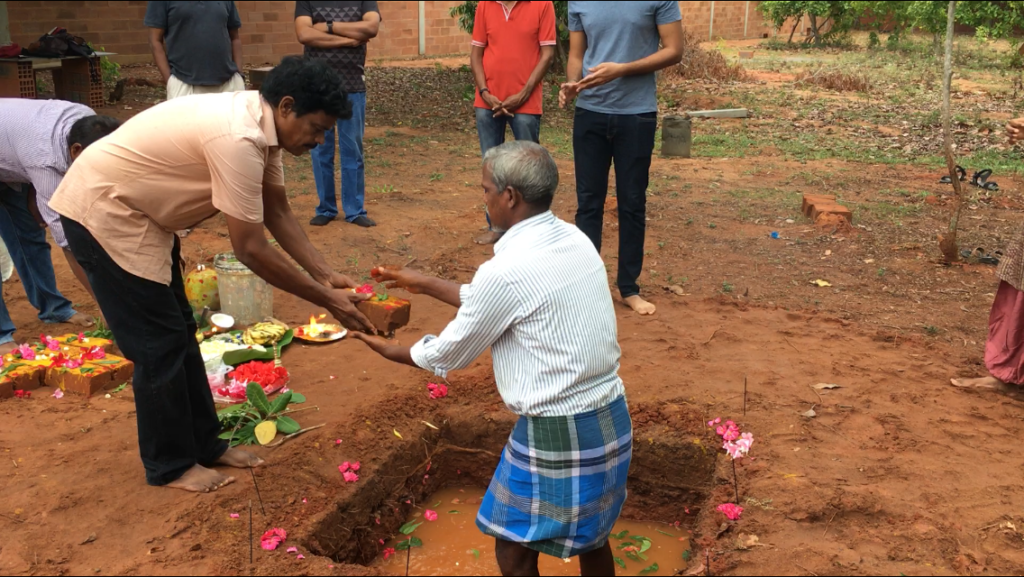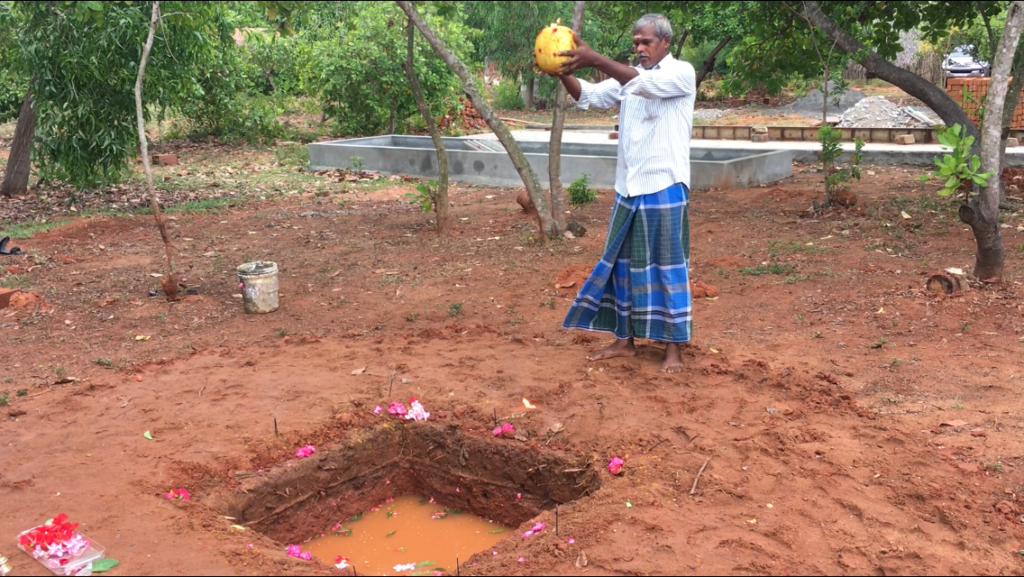A pure day. Naked feet. Red earth.The enchanting smell of rain. The old tall neem tree standing sentinel beside the gathering. A turbulent grey sky ushering in a pleasant light drizzle. An atmosphere devoid of the immense heat and humidity one associates with an Indian summer.
It is 8:30am. Madhi and I have arrived precisely on time. With haste he glided us through the topsy-turvy dirt and asphalt roads on his motorcycle. A select few of the construction team are standing in waiting, having already prepared the puja. They are barefoot, and a few seconds later so are the both of us. The crew is somewhat impatient, as the auspicious morning hours are starting to fleet. Ezhumalai, is the man to conduct the puja. As we gained sight of the others approaching from afar, he promptly cuts a fresh coconut in two with an aruva (billhook knife), and places each half amongst the array of offerings laid carefully on the ground. The others soon join us. They are the client, the rest of our studio team, and the staff of the original Temple Tree Retreat (that is soon to be extended). After greeting each other, we gather to form an impromptu circle. Thus begins the puja.
What grabbed my eyes upon approaching the puja, was the 11 red bricks laying on the soil in an arrowhead formation. A Fibonacci sequence. These bricks were oriented east and pointed towards a freshly dug square pit, measuring approximately 4 x 4ft, with water filling it by a third its depth. This pit was positioned at the absolute centre of one of the buildings to be constructed in the future. I am standing from the south for the entirety of the event.

Each brick was embellished with a coat of tumeric powder and a tripartite of red tikas. Then laid were flowers of Hibiscus, Jasmine, Oleander, Plumeria and Rose, along with neem leaves and coins.1

‘Puja’, ‘Pooja’ or ‘Poojah’, means prayer. This prayer normally takes the form of ceremonial worship. It has been described to me by a colleague as a conversation with the universe; with the powers beyond us; the unseen forces.2 As I have observed, a puja often involves performing a series of rites, accompanied with an assortment of objects. There is the elegant flame of a diya; the trailing soft smoke of incense, and the noble stone idols of the gods. Offerings of fruits and sweets also make an appearance. Typically a brass bell is rung. A mantra or two is chanted. In the past 9 months I have witnessed pujas in the great halls of Chidambaram Temple, in the curated landscape of Upasana during Diwali, and in the humble dwellings of local Tamil families. The puja about to begin before our eyes, is a foundation ceremony for the project I’m working on. Dare I say an architecture puja.
I must admit my knowledge of Hinduism is rudimentary at best. I do know that Hinduism – as understood by the West – is largely based on a British conception of categorising into singular, the plethora of interlinked religious practices spread across the vast Indian subcontinent. This monotonous concept, while once useful to the West and its Christian roots in subverting a culture far removed from itself, is only a concept. Not the reality. As I have gleamed, what is called Hinduism is a vast living system – of diverse spiritual pathways – tracing and retracing themselves upon countless generations. Taking place from the great fertile plains to the boundless Himalayas. Therefore, it is impossible to generalise. Furthermore, the foundation puja I experienced on this pleasant overcast morning should not be interpreted as common practice throughout the land.3
It was briefly explained that the purpose of this puja was to seek blessings from the land and its deep history, that of which is largely unknown and truly beyond us. One must consider that beneath our feet is thousands of years of rich human (and nonhuman) activity, imprinted upon the strata. This is emphasised further by the mutual relationship that at least half of those gathered has with Poppo Pingel, the German Aurovillian architect, who has over the decades unearthed countless fragments of ancient indigenous history.
Our puja formally began with Ezhumalai lighting a soolam (camphor) fixed to a cashew leaf. He then places the soolam down the pit, to float and slowly burn upon the murky water.
All those who were gathered were asked to search and pick up from the site a token of their choosing. A small pile of twigs, leaves and seeds soon formed at the side of the square pit. I picked up a fallen cashew leaf, coloured a strong Autumn-like yellow.
Ezhumalai then carried forth a copper plate of Kumkumam (English: red powder / Hindi: Roli) and Thirneer (English: grey ash / Hindi: chandan) for everyone to mark their foreheads with a potu (Hindi: Tika).
Since the splendid light of the morning was waning, we proceeded with the primary rite, transferring the consecrated bricks to the earth. The client and his small entourage of family and friends were given the honour of firstly transferring the bricks. Then it was the principal architect’s turn, then Mohan’s (the contractor with the killer moustache), then myself, and then finally Vijay (the site supervisor). I was genuinely surprised that I had the opportunity of partaking in this ritual. Perhaps, it is because I interpret my role in such instances as only an observer / foreigner.

The principal architect invited me to partake by stating “and now Ridho should do it, the man behind the project’. That too I found unexpected. It was not an unfounded statement; I have been performing the task of taking the project from a set of requirements, to a concept, to documentation and eventual construction, all the while continuously communicating with various consultants and the contractor. It surprises me how my job is not that far-fetched from what I laboriously studied at university. In terms of semantics, I am more use to being referred to collectively, as a group (the studio), than individually. For at the end of the day, realising architecture is a collective effort.

Onward to the next rite. We are all given a clump of seeds. They are the Navdanya, which means the nine seeds in Hindi. Of those in my hand, I can only name rice, horse gram, wheat and green dal. With a wave of my hand I released them into the pit.
To end the puja, Ezhumalai enacts a rite to remove negative energy from the the land. He stands with a large Poosani Kaai (Ash Gourd) – topped with a flaming soodam (camphor) – clasped in both hands, and gently waves it before his body in circular motions. This occurs for approximately a minute, before he carries the fruit and flame away beyond the boundary of the site and thereby casting out the negative energy.

Although I’ve written a fair amount concerning this puja, that lasted approximately thirty minutes (it felt much longer), I have not really touched upon the deeper meaning/s and history of such a custom. Nor do my Indian friends and colleagues understand well the intricacies of this type of puja. Nevertheless, I felt it worthy of documenting as best I could. It’s not everyday the construction of a building commences, along with a foundation ceremony. It made for an extraordinarily vivid experience, one worthy of marking a new beginning. For of course, the day had only began, and so had officially construction.
1. My colleagues Madhi assisted me with naming the flowers, he is an architect/landscape architect with an incredible amount of knowledge of local flora. Madhi and my other colleague Abishek, assisted me with all the Tamil words I’ve included.
2. I have my former colleague Saloni to thank for this description.
3. The weather reminded me of Melbourne. Overcast, wet and drizzly (though rarely does this city ever experience torrential rain like during the monsoons in India).